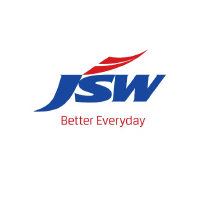
JSW Steel Ltd
NSE:JSWSTEEL


| US |

|
Johnson & Johnson
NYSE:JNJ
|
Pharmaceuticals
|
| US |

|
Berkshire Hathaway Inc
NYSE:BRK.A
|
Financial Services
|
| US |

|
Bank of America Corp
NYSE:BAC
|
Banking
|
| US |

|
Mastercard Inc
NYSE:MA
|
Technology
|
| US |

|
UnitedHealth Group Inc
NYSE:UNH
|
Health Care
|
| US |

|
Exxon Mobil Corp
NYSE:XOM
|
Energy
|
| US |

|
Pfizer Inc
NYSE:PFE
|
Pharmaceuticals
|
| US |

|
Palantir Technologies Inc
NYSE:PLTR
|
Technology
|
| US |

|
Nike Inc
NYSE:NKE
|
Textiles, Apparel & Luxury Goods
|
| US |

|
Visa Inc
NYSE:V
|
Technology
|
| CN |

|
Alibaba Group Holding Ltd
NYSE:BABA
|
Retail
|
| US |

|
3M Co
NYSE:MMM
|
Industrial Conglomerates
|
| US |

|
JPMorgan Chase & Co
NYSE:JPM
|
Banking
|
| US |

|
Coca-Cola Co
NYSE:KO
|
Beverages
|
| US |

|
Walmart Inc
NYSE:WMT
|
Retail
|
| US |

|
Verizon Communications Inc
NYSE:VZ
|
Telecommunication
|
Utilize notes to systematically review your investment decisions. By reflecting on past outcomes, you can discern effective strategies and identify those that underperformed. This continuous feedback loop enables you to adapt and refine your approach, optimizing for future success.
Each note serves as a learning point, offering insights into your decision-making processes. Over time, you'll accumulate a personalized database of knowledge, enhancing your ability to make informed decisions quickly and effectively.
With a comprehensive record of your investment history at your fingertips, you can compare current opportunities against past experiences. This not only bolsters your confidence but also ensures that each decision is grounded in a well-documented rationale.
Do you really want to delete this note?
This action cannot be undone.

| 52 Week Range |
774.5823
1 039.1
|
| Price Target |
|
We'll email you a reminder when the closing price reaches INR.
Choose the stock you wish to monitor with a price alert.

|
Johnson & Johnson
NYSE:JNJ
|
US |

|
Berkshire Hathaway Inc
NYSE:BRK.A
|
US |

|
Bank of America Corp
NYSE:BAC
|
US |

|
Mastercard Inc
NYSE:MA
|
US |

|
UnitedHealth Group Inc
NYSE:UNH
|
US |

|
Exxon Mobil Corp
NYSE:XOM
|
US |

|
Pfizer Inc
NYSE:PFE
|
US |

|
Palantir Technologies Inc
NYSE:PLTR
|
US |

|
Nike Inc
NYSE:NKE
|
US |

|
Visa Inc
NYSE:V
|
US |

|
Alibaba Group Holding Ltd
NYSE:BABA
|
CN |

|
3M Co
NYSE:MMM
|
US |

|
JPMorgan Chase & Co
NYSE:JPM
|
US |

|
Coca-Cola Co
NYSE:KO
|
US |

|
Walmart Inc
NYSE:WMT
|
US |

|
Verizon Communications Inc
NYSE:VZ
|
US |
This alert will be permanently deleted.
 JSW Steel Ltd
JSW Steel Ltd
JSW Steel Ltd
In the vast landscape of the Indian steel industry, JSW Steel Ltd. has carved a significant narrative marked by ambitious expansions and strategic acquisitions. Founded in 1982, this Mumbai-based company is a part of the larger JSW Group, a conglomerate with interests spanning energy, infrastructure, cement, and more. JSW Steel leverages its robust production capacity with an extensive network spanning the breadth of India and forging connections across continents. As one of the largest steel manufacturers in India, the company has expanded its footprint from its integrated steel plant in Vijayanagar to numerous other locations, ensuring a vast production capacity of various steel products. This vast network not only bolsters JSW Steel’s ability to meet the domestic demand but also fortifies its standing on the global stage.
At the heart of JSW Steel's business model lies the integration of its operations, from the raw material phase to the finished product, which ensures efficiency and cost effectiveness. With a product portfolio that spans hot-rolled and cold-rolled coils, galvanized sheets, and various value-added steel products, the company serves an eclectic mix of sectors, including construction, automotive, infrastructure, and energy. Its ability to innovate and invest in state-of-the-art technology has allowed JSW Steel to optimize production processes and consistently improve product quality, keeping them in step with modern demands. The company’s profitability hinges on its well-executed strategy of vertical integration and its nimble responsiveness to market trends, thereby ensuring a sturdy revenue stream even amidst the cyclical nature of the steel industry.

In the vast landscape of the Indian steel industry, JSW Steel Ltd. has carved a significant narrative marked by ambitious expansions and strategic acquisitions. Founded in 1982, this Mumbai-based company is a part of the larger JSW Group, a conglomerate with interests spanning energy, infrastructure, cement, and more. JSW Steel leverages its robust production capacity with an extensive network spanning the breadth of India and forging connections across continents. As one of the largest steel manufacturers in India, the company has expanded its footprint from its integrated steel plant in Vijayanagar to numerous other locations, ensuring a vast production capacity of various steel products. This vast network not only bolsters JSW Steel’s ability to meet the domestic demand but also fortifies its standing on the global stage.
At the heart of JSW Steel's business model lies the integration of its operations, from the raw material phase to the finished product, which ensures efficiency and cost effectiveness. With a product portfolio that spans hot-rolled and cold-rolled coils, galvanized sheets, and various value-added steel products, the company serves an eclectic mix of sectors, including construction, automotive, infrastructure, and energy. Its ability to innovate and invest in state-of-the-art technology has allowed JSW Steel to optimize production processes and consistently improve product quality, keeping them in step with modern demands. The company’s profitability hinges on its well-executed strategy of vertical integration and its nimble responsiveness to market trends, thereby ensuring a sturdy revenue stream even amidst the cyclical nature of the steel industry.





























 You don't have any saved screeners yet
You don't have any saved screeners yet
